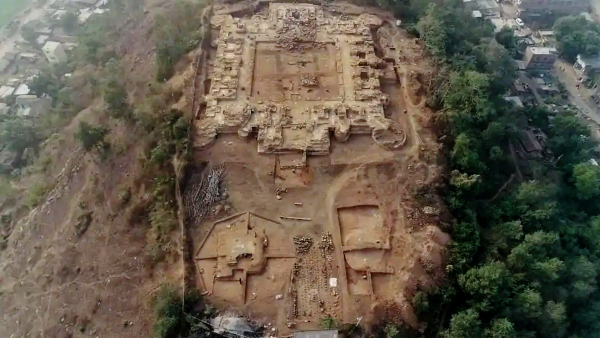Hilltop Buddhist Monastery Uncovered in Eastern India
The first hilltop Buddhist monastery of the Gangetic Valley has been found at Lal Pahari in Lakhisarai district of the state, said its excavation team director Anil Kumar. Excavated during a joint collaboration of the Bihar Heritage Development Society, a part of the department of art, culture and youth affairs and the Visva-Bharati University, Santiniketan, West Bengal, this finding is believed to be a great centre of Mahayana Buddhism.
The 11th-12th century common era (CE) monastery has some unique features rarely found elsewhere in the country and certainly not in Bihar. Besides wooden votive tablets found, it is the first Buddhist monastery which had a woman monk named Vijayashree Bhadra as its chief. She used to receive donations from Pala queen Mallika Devi.
A large number of metal bangles have been found and all its cells had doors, something unusual for the Buddhist monasteries excavated so far, suggesting that either it was exclusively for woman monks or a mixed one.

The two burnt clay seals recovered from the site record the name Srīmaddharmahāvihārik āryabhikṣusaṅghasya (the council of monks of Śrīmaddhama vihāra). The language used is Sanskrit and the script is Siddhamātṛkā of about 8th-9th century CE.
The name is equally significant as it indicates how much prestige the Mahāyāna Buddhism enjoyed in early medieval Magadha.
The wooden votive tablets of 5.3×2.3cm each have the figure of a person, probably Buddha, sitting in Padmasana in Bhumisparsha mudra. The lintel at the entrance of the main sanctum sanctorum represents the two Bodhisattvas — Manjushri and Avalokiteshvara.
Anil, who is the head of the ancient history and archaeology department at Visva-Bharati in Santiniketan, said it’s the first ‘vihara’ in the state, which probably gave Bihar its name, like those found at Nalanda, Vikramshila and Telhara were ‘mahaviharas’.
Also, after Nalanda and Telhara in Bihar, any monastic sealing has mentioned the monastery name. While a number of mahāvihāras and in one instance a vihārikā is known from epigraphic and archaeological records of eastern India, no evidence of a ‘vihara’-level monastic architecture has been so far discovered from any part of Bihar.
The only parallel evidence is found in a monastery excavated at Jagjivanpur in northern Bengal, he said.
These findings will be significant in the understanding of the history of monastic Buddhism in early medieval Magadha in general and the history of the historically identified Kṛmilā region in Lakhisarai in particular. This evidence clearly proves that the monastery atop Lal Pahari at Jaynagar was a ‘vihāra’, he explained.
He said the interconnected cells, wooden door frames, three huge bastions on each side of the monastery, the discovery of dozens of wooden inscribed seals/sealings and the evidence of application of red, green, yellow, white and black colours on lime-plastered floors make the architecture of this monastery the first of its kind among the eastern Indian Buddhist establishments.
Anil said this was the first excavation project completed within 3 years in Bihar after getting a licence from the Archaeological Survey of India (ASI) and signing a memorandum of understanding (MoU) with the Bihar government in 2017. CM Nitish Kumar had inaugurated the Lal Pahari excavation site on November 25, 2017.
“We have documented 500 sculptures lying all around the site and brought 200 of them to Lakhisarai. The state government should urgently preserve these sculptures as Lal Pahari is one of the five protected monuments of Bihar government in Lakhisarai.
The other four are Satsanda, Bichhwe, Ghosi Kundi and Lai. The 6th site at Nongarh is also being considered for inclusion in the list,” Anil told TOI.





